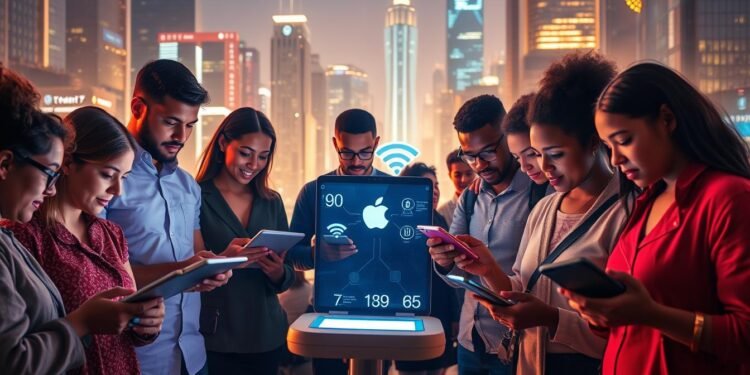What if the key to unlocking economic opportunity, quality education, and better healthcare for millions of Americans has been hiding in plain sight—yet remains frustratingly out of reach?
This question lies at the heart of one of today’s most pressing challenges. The push for broader digital inclusion goes far beyond just getting people online. It’s about ensuring everyone can afford, understand, and use technology to improve their lives.
The COVID-19 pandemic made these gaps impossible to ignore. At one point, an estimated 15–16 million students lacked the internet or devices needed for remote learning. This crisis revealed how deeply access to technology shapes daily life.
True inclusion means more than just connectivity. It includes digital literacy, relevant content, and support to use tools effectively. This guide explores past efforts and current strategies to close the divide and build a more equitable future.
Key Takeaways
- Digital inclusion affects economic, educational, and health outcomes.
- Access alone is not enough—affordability and skills matter too.
- The pandemic highlighted major gaps, especially for students.
- Solutions involve community efforts, training, and policy changes.
- Organizations like Telefónica have already helped over a million people gain digital skills.
- Reports from Pew Research and the National Broadband Plan guide current strategies.
- Building inclusive tech access supports broader societal and economic goals.
Understanding Digital Inclusion: More Than Just Access
Imagine a world where everyone can fully participate in our technology-driven society. This vision goes far beyond simply having an internet connection. It’s about creating equal opportunities for all people to thrive in the modern world.

Defining Digital Inclusion in Modern Society
The concept means ensuring individuals and groups can access and use information and communication technologies effectively. According to the 2011 Building Digital Communities framework, it’s about more than just physical access.
The Digital Equity Act of 2021 expanded this definition significantly. It now includes affordable access, appropriate devices, digital literacy training, and applications that enable self-sufficiency. This comprehensive approach recognizes that true participation requires multiple elements working together.
The Evolution from Digital Divide to Digital Inclusion
Early discussions focused on the digital divide – the gap between those with and without technology access. This perspective primarily highlighted disparities in connectivity and hardware availability.
Over time, the conversation evolved to address broader participation challenges. The shift recognized that having equipment doesn’t guarantee effective use. Today’s approach considers how people actually engage with technology in their daily lives.
This evolution reflects our growing understanding of what meaningful participation requires. It’s not just about infrastructure but about empowering people to use tools effectively.
Key Components of a Digitally Inclusive Community
Several essential elements create truly inclusive environments. Reliable broadband internet forms the foundation for all other components. Without stable connectivity, other efforts cannot succeed.
Appropriate devices that meet user needs are equally important. These tools must be affordable and suitable for various purposes. Digital literacy training helps people develop necessary skills to use technology confidently.
Relevant content and applications encourage collaboration and self-sufficiency. Local libraries, community organizations, and businesses all play crucial roles in supporting these efforts.
Successful strategies adapt to specific community needs and resources. This tailored approach ensures solutions address local barriers effectively. When implemented well, these components create environments where everyone can participate fully in our digital world.
Why Digital Inclusion Matters: Economic and Social Impacts
The transformative potential of modern tools extends far beyond convenience when accessible to every community member. These benefits touch nearly every aspect of daily life, creating measurable improvements in economic stability, educational outcomes, and public wellbeing.
Employment and Economic Development Benefits
Technology access directly influences employment opportunities and economic growth. Research shows internet use among adults 25+ increases employment probability by 6 percentage points.
Household connectivity contributes another 3 percentage point boost according to NTIA’s 2013 report. These numbers represent real job opportunities for thousands of Americans.
PricewaterhouseCoopers identified broader economic gains in their 2009 analysis. Benefits include improved education outcomes, health improvements, and efficiency savings for public services.
The National Broadband Plan emphasized how technological access drives innovation and global competitiveness. Companies like Telefónica have demonstrated this through digital skills training for over one million people.
Educational Advancement Through Digital Access
The pandemic revealed critical gaps in educational technology access. Common Sense Media reported 15-16 million U.S. students lacked adequate internet or devices for remote learning.
This shortage created significant learning disruptions during crucial academic periods. Students without proper tools fell behind their better-equipped peers.
Digital literacy training bridges these educational gaps effectively. It prepares students for technology-driven classrooms and future workforce demands.
Vancouver Public Schools’ initiatives show how comprehensive access supports academic success. Their programs demonstrate measurable improvements in student engagement and performance.
Healthcare Access and Public Safety Improvements
Technology connectivity revolutionizes healthcare delivery and emergency response systems. Telemedicine allows remote consultations with healthcare professionals.
This is particularly valuable in rural areas with limited medical facilities. Patients can access specialists without traveling long distances.
Health information access empowers individuals to make better wellness decisions. People can research symptoms, treatment options, and preventive care strategies.
Emergency communication systems rely on robust technological infrastructure. Quick alerts and coordinated responses save lives during crises.
Civic Participation and Community Engagement
Digital tools transform how people engage with government and community decision-making. Online platforms enable easier access to public services and information.
Voting systems, town hall meetings, and policy discussions increasingly move online. This creates more transparent and accessible governance processes.
Community forums and social platforms strengthen local connections. They reduce isolation and foster collaborative problem-solving.
Marginalized groups gain powerful voices through technological platforms. These tools help overcome traditional socioeconomic barriers to participation.
Despite these clear benefits, significant disparities persist in who can access these opportunities. The next section examines who’s being left behind in America’s technological landscape.
The Current Landscape: Who’s Being Left Behind in America
A closer examination reveals persistent gaps in who can access and benefit from modern technological tools in the United States. These disparities follow clear patterns across demographic groups and geographic regions, creating barriers that prevent full participation in our increasingly connected society.

Demographic Patterns of Digital Exclusion
Research from Pew shows that 15% of Americans remain offline. This number climbs significantly among specific groups. Those without a high school diploma show a 41% non-use rate.
Senior citizens face particular challenges with 44% not using the internet. Low-income households report 24% non-use rates. Hispanic communities show a 24% offline rate according to the same 2013 data.
Geographic Disparities in Connectivity
Rural areas experience pronounced connectivity challenges. NTIA’s 2013 report revealed troubling statistics for specific rural communities.
Only 16% of African American households without high school diplomas in rural areas had home broadband. This highlights how geography compounds existing socioeconomic barriers.
Infrastructure gaps in remote regions limit high-speed internet availability. These physical access issues create foundational obstacles for rural residents.
Barriers to Digital Inclusion
Multiple interconnected obstacles prevent people from fully engaging with technology. The NTIA Broadband Adoption Toolkit categorizes these into four main areas.
These include awareness, cost, training, and content relevance. Each barrier affects different groups in distinct ways according to research.
Cost and Affordability Challenges
Financial constraints represent a significant hurdle for many Americans. Pew Research found that 19% of non-users cite cost as their primary barrier.
This challenge disproportionately affects specific communities. Digital Cities research shows affordability impacts low-income groups most severely.
Latino communities and women face particular financial barriers. Less-educated individuals also struggle with device and service costs.
Digital Literacy and Skills Gaps
Nearly one-third of non-users (32%) report skills gaps as their main obstacle. Many people lack confidence in their ability to use technology effectively.
This knowledge deficit creates a cycle of exclusion. Without basic skills, people cannot access online resources that could improve their situation.
The pandemic highlighted this issue dramatically. Some 15-16 million students lacked devices or internet for remote learning.
Relevance and Perception Barriers
Perceived lack of relevance keeps 34% of non-users offline according to Pew. Some people don’t see how technology applies to their daily lives.
Digital Cities research shows this barrier varies by demographic. Older and higher-income individuals often cite lack of interest.
This perception gap can perpetuate low adoption rates. Without seeing value in technology use, people have little incentive to overcome other barriers.
Understanding these complex, interconnected challenges is essential for developing effective solutions. The next section explores strategies that address these specific barriers through targeted approaches.
Strategies for Building Digitally Inclusive Communities
Effective approaches to closing the technology gap involve multiple coordinated efforts across infrastructure, affordability, education, and policy. These strategies work together to create environments where everyone can participate fully in our connected society.
Infrastructure Solutions: Expanding Broadband Access
Reliable internet forms the foundation for all other inclusion efforts. Expanding broadband deployment in underserved areas addresses critical connectivity gaps.
Free WiFi zones in public spaces provide immediate access points for community members. Public computers in libraries and community centers offer essential resources for those without personal devices.
Companies like Telefónica demonstrate successful infrastructure expansion. Their 4G/LTE coverage reaches 92% of markets, showing what’s possible with committed investment.
Affordability Programs and Partnership Models
Cost remains a significant barrier for many individuals and families. Partnership models with internet service providers create discounted service options.
Low-cost device distribution programs make technology accessible to low-income households. Government subsidies help bridge the financial gap for those who need support most.
These affordability solutions directly address economic barriers identified in previous research. They make essential services achievable for everyone.
Digital Literacy Training and Education Initiatives
Skills development is crucial for effective technology use. Libraries, community centers, and schools serve as ideal training locations.
Project-based learning methods focus on practical outcomes. Job searching, health management, and communication skills receive particular emphasis.
Vancouver Public Schools integrated teaching and learning into their comprehensive approach. This shows how educational institutions can lead skills development efforts.
Community-Based Technology Centers and Resources
Local hubs provide essential access and education resources. Community technology centers function similarly to international telecentres.
These centers offer computer labs, trained instructors, and supportive environments. They become gathering places for skill development and collaboration.
Using existing resources like schools for after-hours training maximizes community benefits. This approach makes efficient use of available infrastructure.
Policy Approaches and Government Support
Government initiatives provide crucial framework and funding support. The Digital Equity Act and National Broadband Plan guide current efforts.
These policies advocate for federal and state support in regulation and funding. They recognize that sustainable solutions require multi-sector collaboration.
Businesses, nonprofits, and government agencies must work together. This coordinated approach ensures comprehensive coverage and effectiveness.
Awareness campaigns and technology fairs demonstrate tangible benefits of technology use. They help overcome relevance barriers by showing practical applications.
Each strategy targets specific challenges identified earlier. When implemented together, they create powerful solutions for building truly inclusive communities.
Conclusion: The Path Forward for Digital Equality
Moving toward true digital equality demands a united effort. Everyone must work together to make sure all people can use technology well. This means giving everyone the tools and skills they need to succeed.
Strong policies and local plans help remove barriers. They make sure training and resources fit each community’s needs. Companies can lead by expanding internet coverage and offering skills programs.
Every person deserves a fair chance to learn, work, and connect. By supporting these efforts, we build a society where everyone can participate and thrive. The future depends on it.
FAQ
What exactly is digital inclusion?
Digital inclusion means ensuring that all individuals and communities have access to and can effectively use technology. It goes beyond just having an internet connection. It includes affordable service, devices, training, and relevant content.
How does broadband access impact economic opportunities?
Broadband access opens doors to employment, remote work, and online job training. Many businesses now require basic tech skills. Without reliable connectivity, individuals may miss out on job listings, career advancement, and economic growth.
Who is most affected by the lack of technology access?
Lower-income households, older adults, rural residents, and some minority groups often face the biggest barriers. These communities may struggle with affordability, availability of service, or necessary training to use tech tools effectively.
What are common barriers to getting online?
Key barriers include high costs for internet service and devices, limited infrastructure in rural areas, and a lack of skills or confidence. Some people also question the relevance of the internet to their daily lives.
How can communities improve digital literacy?
Communities can offer training programs at libraries, schools, or community centers. Workshops on basic internet use, online safety, and job-seeking skills help. Partnerships with local organizations can expand these learning opportunities.
Are there government programs to help with internet costs?
Yes, programs like the Affordable Connectivity Program provide monthly discounts on broadband service for eligible households. Some states and localities also have initiatives to increase access and affordability for residents.





